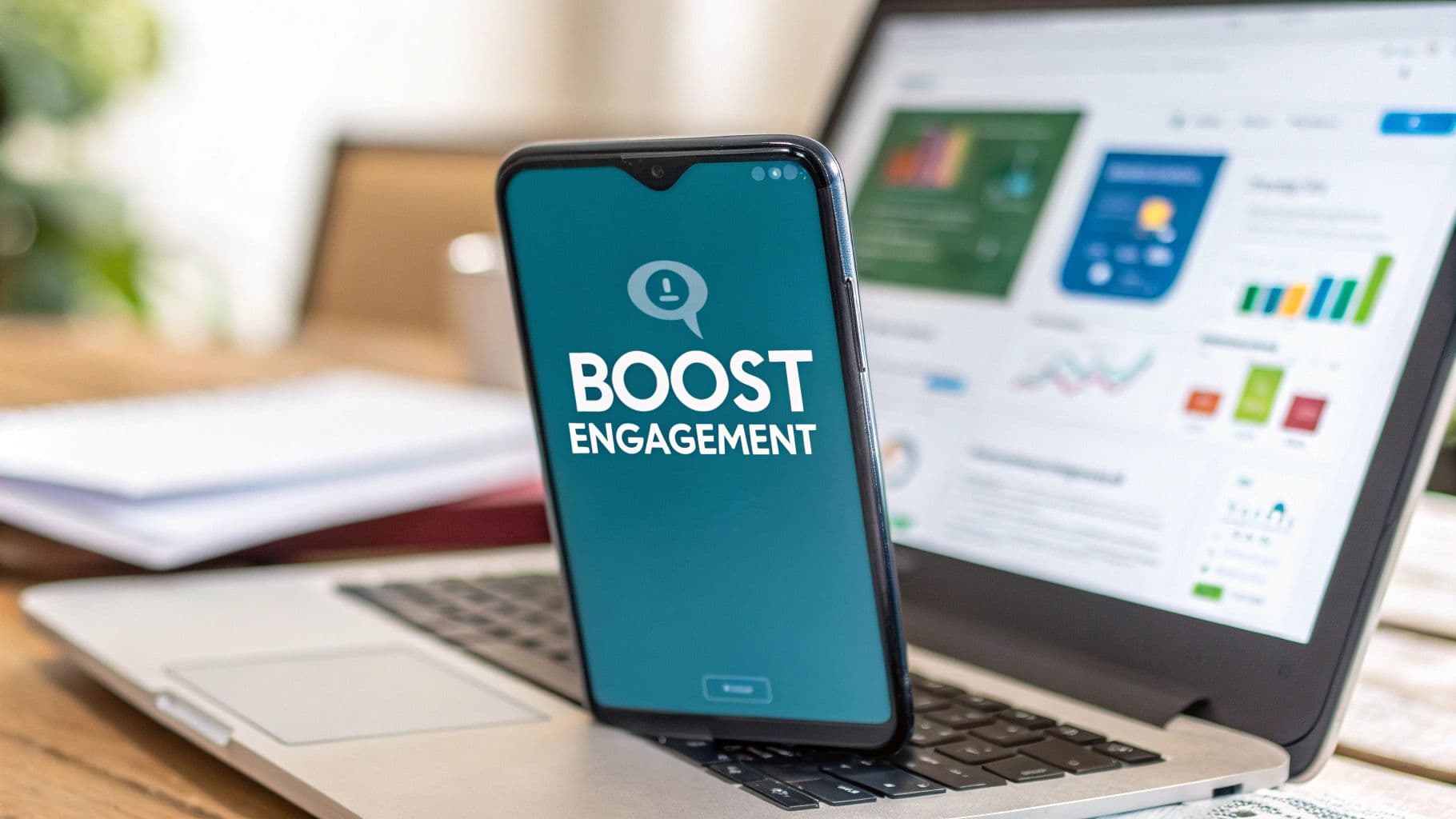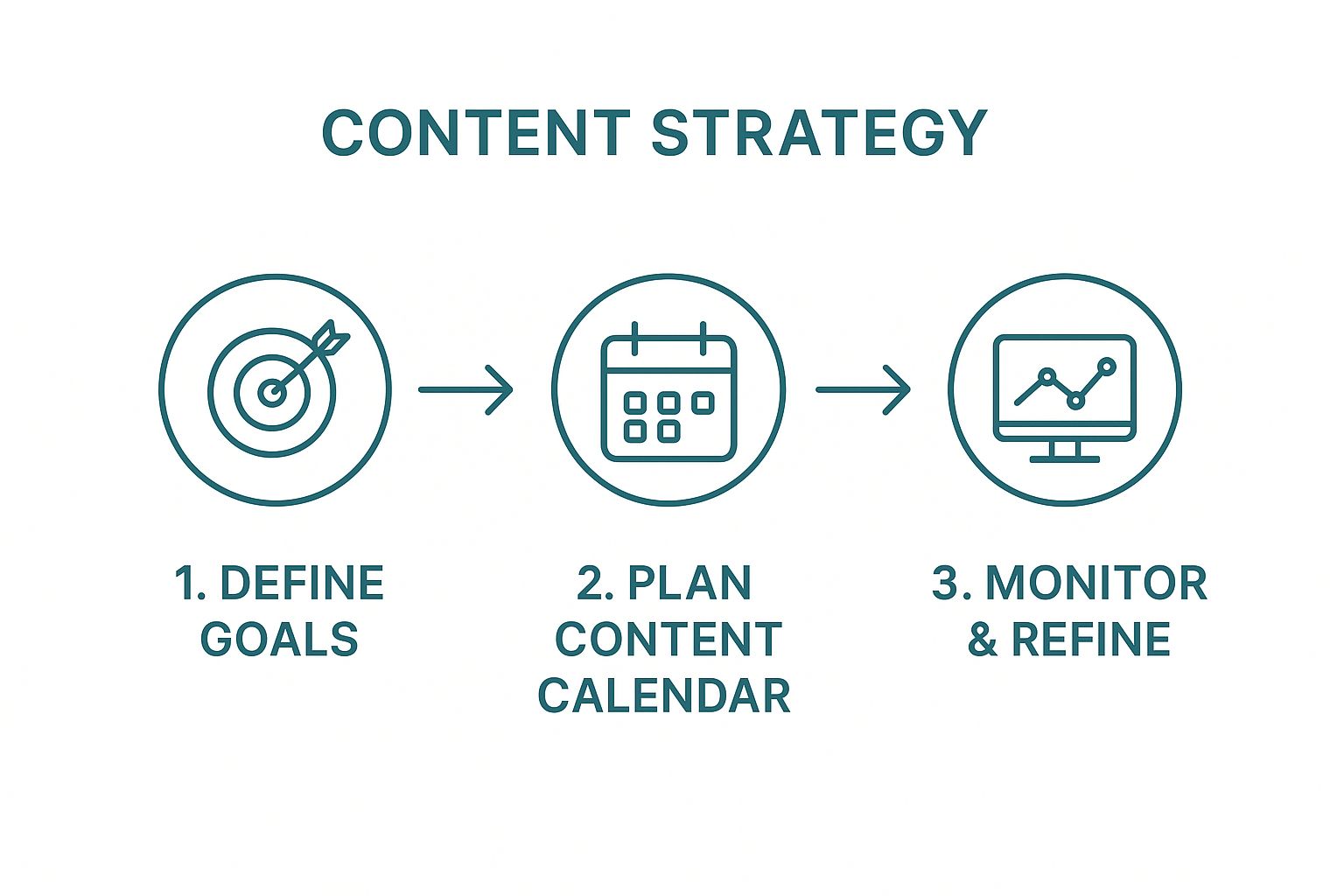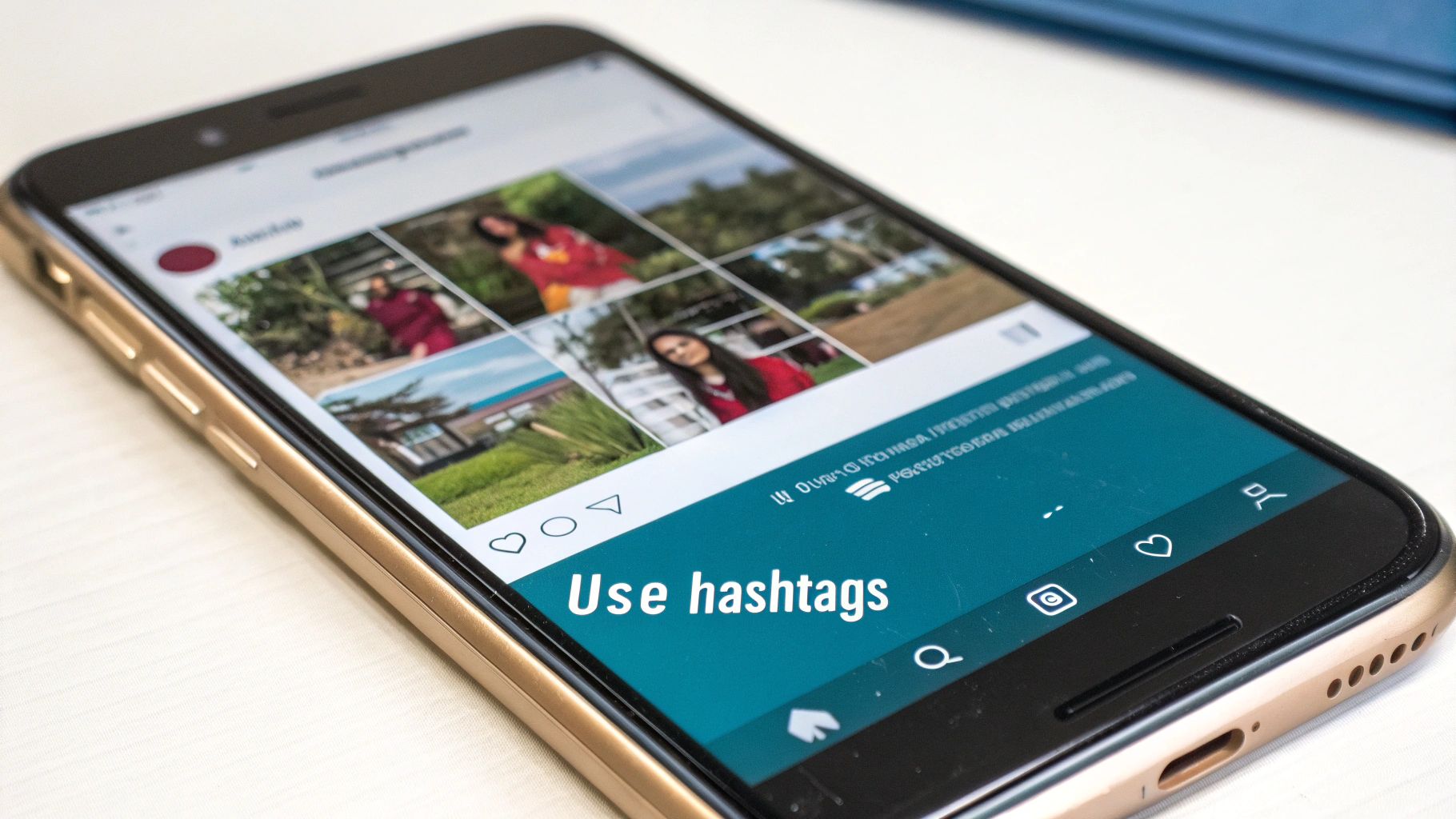
Boosting social media engagement isn't about likes. It's about starting conversations that build a community and drive sign-ups. As a founder, I learned that meaningful engagement—comments, shares, DMs—is the only kind that contributes to the bottom line. Chasing vanity metrics is a waste of time. Making that mental switch is the first step.
Moving Beyond Likes: What Engagement Actually Means
Let's be blunt. Most social media advice is fluff. A post with 1,000 likes and zero comments is noise. It gives you no feedback, builds no loyalty, and doesn't lead to a single sign-up.
Real engagement is a dialogue.
You're not a content creator; you're a founder starting conversations with potential customers. Every comment is feedback. Every share is a user testimonial. Every DM is a lead.
Redefining Your Engagement Goals
We've all been conditioned to see a "like" as a win. It's a low-effort tap that means very little. At BillyBuzz, we rewired our thinking to focus on actions that demand more from the user because they signal real interest.
True engagement isn't measured by the number of people who see your content, but by the number of people who are moved to participate in it. It's the difference between an audience and a community.
This shift is critical. With around 5.45 billion people on social media, attention is the scarcest resource. Your content has to be compelling enough to make them stop, think, and respond.
Prioritizing High-Value Interactions
We categorize engagement into tiers to focus our limited time. A "like" is low-value. A thoughtful question in the comments is a high-value opportunity to build a relationship.
The BillyBuzz Engagement Value Matrix
This is the exact framework we use to prioritize where we spend our time.
| Engagement Tier | Actions (Examples) | Business Value |
|---|---|---|
| High-Value | Detailed comments, thoughtful questions, shares with personal commentary, direct messages asking for info, user-generated content (UGC). | Highest. Strong buying signals, builds community, provides direct feedback, and creates brand advocates. |
| Mid-Value | Simple comments ("Great post!"), shares without commentary, poll votes, saving a post. | Medium. Indicates active interest and helps with algorithm visibility, but doesn't start a deep conversation. |
| Low-Value | Likes, quick reactions (e.g., ❤️, 👍), profile visits, quick story views. | Lowest. Passive acknowledgment. Good for brand awareness but rarely translates to business impact. |
We live at the top of this matrix.
These high-value interactions show someone is actively thinking about our product or point of view. When you grasp the power of immediate, two-way communication, you'll understand why real-time engagement is so crucial for startup success. These conversations are where you find your most passionate users.
Forget likes. Build a foundation for growth, one genuine conversation at a time.
Our Playbook for Content That Sparks Conversation

Generic content kills engagement. When we first started BillyBuzz, our posts were soulless. Predictably, they got zero interaction.
The secret isn't creating more content; it's creating content that invites a response.
Our content engine runs on a simple philosophy: Listen First, Create Second. We stopped guessing. We started building content around conversations people were already having. This led to three content pillars that consistently get people talking.
Our Three Pillars of Engaging Content
Think of these as conversation starters, not content "types."
Pillar 1: Tactical Education
We share actionable, nitty-gritty advice a founder can use today. No high-level theory.
A generic post like "Why Reddit is Great for Marketing" will fall flat. We get specific: "The Exact 3-Sentence Template We Use to Respond to Pain Point Keywords on r/SaaS." One is an observation; the other is a tool.
Pillar 2: Relatable Founder Journeys
We share the unpolished reality of building a startup—the wins, but more importantly, the failures.
A post we wrote about a feature launch that flopped got 3x more comments than our polished launch announcement. It was real.
Pillar 3: Interactive Prompts
We directly ask for participation. We run polls ("Which metric do you obsess over most?"), host AMAs ("Ask me anything about bootstrapping to $10k MRR"), and feature user content. These posts have the highest comment-to-like ratio in our arsenal.
The most effective way to boost social media engagement is to stop broadcasting and start facilitating. Your job isn't to be the smartest person in the room, but to build the room where smart people want to talk.
Polish often kills personality. Our most successful posts are the ones we spend the least time overthinking. A screenshot of a surprising analytics spike with a question—"What's the one metric that surprised you this week?"—drove more conversation than a perfectly designed graphic ever did.
Designing for the Mobile Feed
Knowing how people see your content is as crucial as what you create. A staggering 80% of all social media activity happens on a phone. This isn't a fun fact; it's a creative constraint. You can dig deeper into these mobile usage trends on DataReportal.
This reality forced us to adopt a mobile-first workflow:
- Vertical video is king. All video is shot and edited in 9:16. No exceptions.
- Text must be scannable. We use short sentences, bullet points, and bold text.
- The hook is everything. The first line of a caption or the first three seconds of a video must earn attention. If it doesn't, we rewrite it.
This repeatable framework—listening, structured pillars, and a mobile-first mindset—is how we create content that gets people talking.
Finding Your Audience in Niche Communities
Forget dragging an audience to your doorstep. Go where they already are. For us, that's Reddit. While X and Instagram are deafeningly loud, niche subreddits are goldmines of unfiltered conversations.
We put our energy into communities where our ideal customers are actively asking for help. This isn't about spamming links. It’s about becoming a helpful voice at the right moment.
Pinpointing the Right Subreddits
The trick is to find subreddits where people discuss the problems your product solves. For a tool like BillyBuzz, we are regulars in these subreddits:
- r/SaaS: Ground zero for founders talking growth, churn, and marketing.
- r/marketing: Broader, but invaluable for lead gen and acquisition conversations.
- r/startups: Founders sharing raw, unfiltered struggles—perfect for spotting pain points.
- r/ProductManagement: Discussions on user feedback and building features people want.
The most valuable conversations weren't about "social media tools." They were about "how do I find my first 10 customers?" That’s where we can step in and offer real value.
Finding the right communities is the most critical step in our engagement strategy.

As you can see, planning is just the start. The real work is in constantly monitoring and tweaking your strategy.
Using AI to Listen at Scale
Manual monitoring is impossible. It's why we built BillyBuzz—to put this listening process on autopilot. We use our own tool to set up hyper-specific, AI-powered alerts that act as our eyes and ears.
Here are the exact alert rules we have running 24/7 inside BillyBuzz:
- Pain Point Keywords: We listen for "customer acquisition," "finding beta users," "tired of manual outreach," and "how to get feedback."
- Competitor Mentions: We have alerts for when people mention competitors, especially in threads asking for alternatives (e.g.,
(competitor_A OR competitor_B) AND (alternative OR vs)). - "Looking for a tool" Alerts: We track phrases like
"tool to monitor Reddit","any software for", or"recommend an app that...".
These alerts go straight to our #mentions channel in Slack, so we can jump into a conversation the second it happens. Our guide on how to get customers from Reddit in 2025 breaks down this entire playbook.
Crafting the Perfect Value-First Response
When an alert pops, the goal is never to pitch. It’s to help. We have a response template we stick to that ensures we’re adding to the conversation.
The BillyBuzz Response Template:
- Acknowledge and Validate: "That's a tough spot; finding those first users is a real grind."
- Offer Actionable Advice (No Product Mention): "What worked for us was picking one subreddit and manually replying to every relevant post for a month. It built a ton of goodwill."
- Subtle, Optional Self-Reference: "We ended up building a tool to automate this listening process, but the manual method is a great way to start."
This positions you as an expert, not a salesperson. People get curious, check your profile, and find their way to your brand without a hard sell.
How We Turn Comments Into Community Assets

A post is just the opening line. The real work begins in the replies. If you just broadcast content, you're missing the point. Managing comments well is how you turn followers into a community.
At BillyBuzz, every comment is an opportunity. It’s a chance to clarify our message, show we’re listening, and build a relationship. You need a system.
Our A.V.E. Framework for Responding
We developed a simple, three-part framework called 'A.V.E.' to guide our team. It ensures every response is thoughtful.
Here’s how it breaks down:
- Acknowledge: Directly address what the person said. Show you read their point.
- Value: Add something new. An extra statistic, a link, or a deeper insight.
- Encourage: Keep the ball rolling. End with an open-ended question.
Responding to comments isn't a task. It's a public demonstration of your brand's personality. Each reply shows potential customers that you're attentive, helpful, and worth their trust.
For a question about our product, an A.V.E. response looks like this:
- Acknowledge: "Great question about setting up keyword alerts."
- Value: "Quick tip: use quote marks around a phrase, like "customer feedback," to get exact matches. It filters out the noise."
- Encourage: "What kind of topics are you hoping to track?"
This turns a Q&A into a public resource. A thoughtful approach is a must, and this guide on how to build an online community that thrives is a fantastic resource.
Handling Praise and Criticism With A Plan
The A.V.E. framework gives us a playbook for the good and the bad.
When someone leaves praise:
- Acknowledge: "So glad you're finding the AI alerts useful!"
- Value: "We've found that setting up alerts for competitor mentions is a game-changer for spotting market gaps."
- Encourage: "Is there a specific feature you’ve found most valuable?"
When we get tough criticism:
- Acknowledge: "Thanks for bringing this up. I understand your frustration with the alert delays you saw last week."
- Value: "We identified a server issue and pushed a fix on Tuesday. You should see a major improvement in speed."
- Encourage: "Could you let me know if you’re still seeing any lag?"
By sticking to this structure, every interaction reinforces our brand, educates our audience, and makes people feel heard. That’s how you build engagement that matters.
Measuring Engagement That Actually Drives Business

As a founder, I live by a simple rule: if you can't measure it, you can't improve it. Vanity metrics don’t keep the lights on. Is your social media effort moving the needle?
We got ruthless about what we track. We focus on a handful of KPIs that tell us if our strategy is working. These give us a clear signal, not just noise.
The KPIs We Obsess Over at BillyBuzz
We look past surface-level numbers to find metrics that signal intent. These are the stats we review every week.
Here are our core KPIs:
- Comment-to-Like Ratio: A post with tons of likes but few comments is a red flag. It’s passive scrolling. We aim for a healthy ratio because it proves we're sparking conversation.
- Share Rate on Educational Content: When someone shares our how-to posts, it’s the ultimate endorsement. It tells us we’re providing real value.
- Social Referral-to-Trial Rate: We track how many website visitors come from social. But we go deeper: what percentage of that specific traffic signs up for a BillyBuzz trial?
To truly understand what drives business value, it's essential to move beyond vanity metrics and focus on understanding key social media engagement metrics. This shift helps you connect your daily social activities to tangible business outcomes.
Connecting these dots is everything. We use a mix of platform analytics and our own internal dashboards to tie a specific post or conversation directly back to a new user.
Looking ahead, data screams video. By 2025, projections show that around 78% of people will prefer discovering new products through short videos. And 93% of marketers plan to increase their social marketing investment, meaning the space is only getting more competitive. This data confirms our video strategy is essential for future growth.
The goal isn't just to boost social media engagement. It's to boost the right kind of engagement—the kind that builds your business.
Common Questions from Fellow Founders
As a founder, social media often feels like one more thing on an endless to-do list. I’ve talked with countless other founders who are stuck.
Here are the most common questions I get, with the no-fluff answers we’ve learned the hard way.
How Much Time Should a Founder Realistically Spend on Social Media?
Mindless scrolling isn't a strategy. Your time is your most precious resource.
We've found the sweet spot is a focused 30-45 minutes a day. Consistency is key. A focused half-hour every day beats a four-hour scramble once a week. This is where a tool like BillyBuzz is a game-changer; it automates the listening so you can jump directly into conversations that matter.
What Should I Do When a Post Gets Zero Engagement?
First, don't panic, and don't delete the post. It happens to everyone.
Treat it as a data point. Every flop is a free lesson. Ask yourself:
- Was the hook interesting enough?
- Was the topic too broad or too niche?
- Did I give a clear reason to comment?
Ask a few people you trust for their unfiltered feedback.
A post with zero engagement isn't a reflection of your brand's value; it's a piece of feedback from the market telling you to adjust your messaging. Listen to it.
Learning what doesn't work is as critical as celebrating wins.
Should I Be on All Platforms or Master Just One?
Trying to be everywhere is a recipe for burnout. Go deep on one or two channels before expanding.
Where is your audience actually having conversations? For us, it was Reddit and X. We poured all our energy there first. Once you have a system that works, then you can look at others. Just remember to tailor your content for each platform—what kills it on X might fall flat on LinkedIn.
Ready to stop guessing and start engaging where it counts? BillyBuzz uses AI to find your next customers on Reddit, sending you real-time alerts for conversations you can't afford to miss. Start your free trial today and turn Reddit into your most powerful customer acquisition channel.
